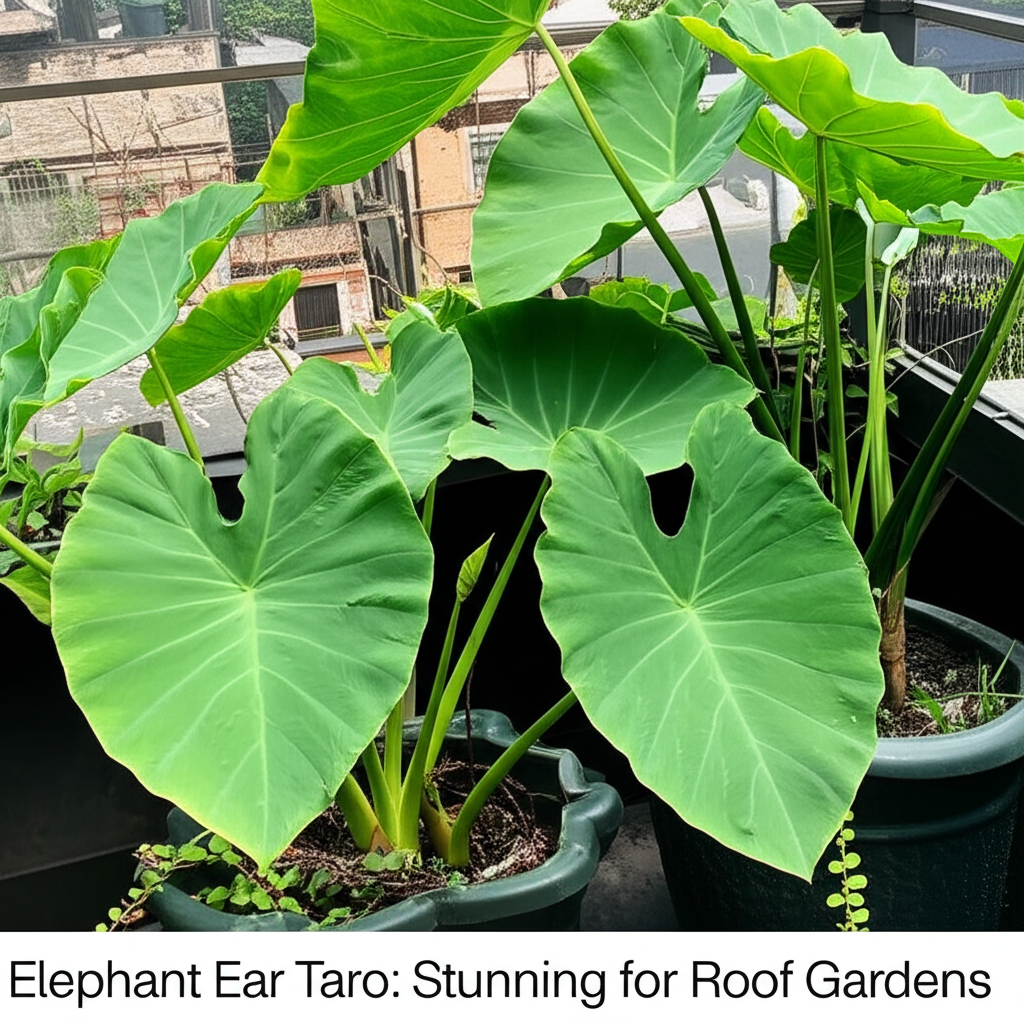How to Prune Elephant Ear Taro Plants: An Easy Guide to Thriving Growth

Ever gazed at the majestic, oversized leaves of your elephant ear taro and wondered about their care? Perhaps you’ve noticed a leaf turning yellow or your plant seems to be taking over its designated space. Understanding how to prune elephant ear taro plants is key to maintaining their stunning beauty, promoting vigorous new growth, and preventing them from becoming overgrown. Proper pruning isn’t just about aesthetics; it directly impacts your plant’s health, its ability to produce those iconic, dramatic leaves, and even the overall vitality of your garden ecosystem.
Quick Answer Box
How to prune elephant ear taro plants involves removing dead, damaged, or yellowing leaves, as well as managing their size and spread. This process encourages healthier new growth, improves air circulation, and prevents the plant from becoming leggy or overcrowded. Regular, judicious pruning is essential for maintaining the plant’s vigor and aesthetic appeal.
What is Elephant Ear Taro Pruning and Why It’s Important in Gardening
Elephant ear taro, scientifically known as Colocasia esculenta (and various other related genera like Alocasia), are beloved for their large, heart-shaped or arrowhead-shaped leaves that can add a tropical flair to any garden. These plants are rhizomatous perennials, meaning they grow from underground stems (rhizomes) that produce new shoots and leaves annually. Pruning, in this context, refers to the selective removal of parts of the plant – typically leaves and stems – to influence its growth, health, and appearance.
The importance of pruning elephant ear taro lies in several key areas:
Plant Health: Removing diseased, damaged, or senescing (aging) leaves prevents the spread of potential fungal infections and allows the plant to direct its energy towards new, healthy growth.
Aesthetics: Overgrown or leggy plants can detract from the visual impact. Pruning helps maintain a desirable shape and size, showcasing the plant’s architectural beauty.
Air Circulation: Overcrowded foliage can reduce airflow, creating a humid microclimate that is conducive to pests and diseases. Pruning opens up the plant, allowing for better air circulation.
Energy Allocation: By removing spent or unhealthy parts, you encourage the plant to focus its resources on producing stronger stems and larger, more vibrant leaves.
Rhizome Management: For plants grown in containers or areas where they might spread too aggressively, pruning can help manage the size and spread of the rhizomes.
Quick Recommendations or Key Insights about Pruning Elephant Ear Taro
Prune for Health: Always remove any leaves that are yellow, brown, spotted, or damaged.
Manage Size: Cut back leaves that are touching the ground or becoming too large for their space.
Timing is Flexible: You can prune elephant ears throughout their growing season as needed, but major pruning is best done in early spring or late fall.
Use Clean Tools: Always use sharp, sterilized pruning shears or a knife to make clean cuts and prevent disease transmission.
Don’t Over-Prune: Avoid removing more than one-third of the plant’s foliage at any one time to prevent shocking it.
Be Mindful of Sap: The sap of some elephant ear varieties can be irritating to the skin, so wear gloves.
Detailed Breakdown of How to Prune Elephant Ear Taro Plants
Pruning elephant ear taro is a relatively straightforward process, but understanding the “why” behind each cut makes it even more effective.
The Art of Leaf Removal: Timing and Technique
The most common reason for pruning elephant ear taro is to manage its leaves. As the growing season progresses, older leaves naturally start to yellow and eventually turn brown. These are prime candidates for removal.
Identifying Leaves to Prune: Look for leaves that are:
Yellowing: This is a natural sign of aging, but if many leaves yellow simultaneously, it could indicate issues like overwatering, underwatering, or nutrient deficiency.
Brown or Crispy: These leaves are no longer photosynthesizing effectively and are taking energy away from new growth.
Damaged: Torn, shredded, or nibbled leaves can be unsightly and may harbor disease.
Touching the Ground: Leaves that lie on the soil surface are more susceptible to fungal diseases and pests.
Overcrowding: If the plant is becoming too dense, thinning out some of the older or weaker leaves will improve air circulation.
The Pruning Process:
1. Gather Your Tools: You’ll need sharp, clean pruning shears, bypass pruners, or even a sharp gardening knife. Sterilize your tools with rubbing alcohol or a bleach solution between plants or if you suspect disease.
2. Locate the Base: Find where the leaf stalk (petiole) emerges from the base of the plant or the rhizome.
3. Make a Clean Cut: Cut the petiole as close to the base as possible, ideally just above the soil line or where it joins the main stem. This encourages a clean wound that can heal quickly. Avoid leaving long, dangling stalks, which can become entry points for pests and diseases.
4. Dispose of Debris: Remove the pruned leaves from the garden, especially if they show signs of disease, to prevent its spread.
Managing the Plant’s Size and Spread
Elephant ears can grow quite large and, in favorable conditions, can spread rapidly through their rhizomes. Pruning can help control this expansion.
Cutting Back Overgrown Foliage: If your elephant ear has become too dense or is encroaching on pathways or other plants, you can selectively remove entire stems. Aim to remove about one-third of the oldest or weakest stems at a time to avoid stressing the plant.
Rhizome Management (for containment): While not strictly “pruning” in the leaf sense, managing rhizome growth is crucial for containment. If your elephant ear is in a pot, you might need to repot it annually or every other year. During repotting, you can divide the rhizomes, effectively pruning back the plant’s spread. If it’s in the ground and you want to limit its spread, you might need to dig around the perimeter to sever any encroaching rhizomes.
Pruning for Dormancy and Overwintering
In colder climates where elephant ears are not perennial, they will go dormant. Pruning plays a role in preparing them for this period.
Fall Cleanup: As temperatures drop and the foliage begins to naturally die back, you can cut all the foliage down to the ground. This makes overwintering the rhizomes easier and tidier.
Rhizome Preparation: After cutting back the foliage, you can either leave the rhizomes in the ground (if you have a suitable climate and protection) or dig them up to store indoors for the winter. If digging them up, brush off excess soil and allow them to dry for a few days before storing them in a cool, dry, dark place.
Practical Applications in the Garden
Applying pruning techniques to your elephant ear taro is straightforward and beneficial for your gardening routine.
Daily/Weekly Checks: Take a moment during your watering rounds to spot and remove any leaves that have just started to yellow or show damage. This small, consistent effort keeps the plant looking its best and prevents small issues from becoming larger problems.
Seasonal Spruce-Up: In early spring, before new growth really takes off, it’s a good time to clear out any remaining dead foliage from the previous year and assess the plant’s overall shape. Similarly, in late fall, after the first frost or as the plant naturally dies back, a thorough cleanup is beneficial.
Container Gardening: For elephant ears in pots, pruning is essential for managing their size within the container. Regularly removing older leaves and, when repotting, dividing overgrown rhizomes keeps them healthy and prevents them from outgrowing their pots.
Mixed Borders: When planting elephant ears in mixed borders, be mindful of their mature size. Pruning helps ensure they don’t shade out smaller, sun-loving plants or become an unruly focal point.
Common Mistakes to Avoid
Even with a simple task like pruning, gardeners can make mistakes that hinder their elephant ear’s growth.
Over-Pruning: The most common mistake is removing too much foliage at once. This can shock the plant, stressing it and potentially delaying new growth or even causing it to weaken. Tip: Aim to remove no more than one-third of the plant’s total foliage at any given time.
Using Dull or Dirty Tools: This can lead to ragged cuts that are slow to heal and more susceptible to disease. Tip: Always use sharp, sterilized pruning shears or a knife.
Leaving Stubs: Cutting too far from the base or leaving long, dead stalks can create entry points for pests and diseases. Tip: Cut as close to the base as possible, just above the soil line.
Not Removing Diseased Leaves: If you see spots or signs of fungal issues, failing to remove and discard these leaves can lead to the problem spreading throughout the plant or to other nearby plants. Tip: Be vigilant about removing and properly disposing of any diseased material.
Pruning in Extremely Cold Weather: While you prune back dead foliage in fall, avoid making significant cuts to healthy growth during periods of extreme cold or frost, as this can damage new tissue. Tip: Focus pruning on dead or dying parts, and save any shaping for warmer, active growing periods.
Expert Tips or Pro Insights
Seasoned horticulturists have a few tricks up their sleeves for maximizing elephant ear taro health and beauty through pruning.
The “One-Third Rule” for Major Pruning: If you need to significantly reduce the size of a large elephant ear, follow the one-third rule: never remove more than one-third of the plant’s foliage in a single pruning session. If more needs to be removed, do it in stages over a few weeks.Encouraging Larger Leaves: For the most impressive, specimen-sized leaves, some growers advocate for a more conservative pruning approach. They might only remove leaves that are truly yellow or brown, allowing the plant to maintain maximum photosynthetic surface area. This strategy is often used when aiming for the largest possible leaves for a dramatic display.
The “Sacrificial Leaf” Technique: In some cases, if a plant is showing signs of stress (like wilting due to heat), a gardener might prune off one or two of the largest, oldest leaves to reduce the plant’s overall water demand, allowing it to recover more quickly.
Understanding the Sap: The sap of Colocasia and Alocasia species contains calcium oxalate crystals, which can cause skin irritation and are toxic if ingested. Pro Tip: Always wear gloves when pruning, especially if you have sensitive skin. Wash your hands thoroughly after handling the plant or its sap.
Stimulating New Growth: Lightly pruning or pinching back the tips of very young stems can sometimes encourage a bushier, more compact growth habit, though elephant ears are generally grown for their upright, dramatic form.
Seasonal or Climate Considerations
The approach to pruning elephant ear taro can vary depending on your climate and the season.
Tropical and Subtropical Climates: In regions where elephant ears grow year-round, pruning is primarily focused on maintaining plant health and aesthetics. You’ll be removing yellowing or damaged leaves as they appear throughout the growing season. You might also manage their spread if they become too aggressive.
Temperate Climates (with cold winters): In areas that experience freezing temperatures, elephant ears are typically grown as annuals or their rhizomes are overwintered indoors.
Spring: As new shoots emerge from the ground, clear away any remaining debris from the previous year. You can also prune any damaged parts of emerging shoots.
Summer: Prune away any yellowing or damaged leaves as they appear to maintain the plant’s health and appearance.
Fall: After the first frost, the foliage will turn black and die back. At this point, you can cut all the stems down to about 2-3 inches above the soil line. This makes it easier to lift the rhizomes for storage or to protect them in situ.
Planting Zones: USDA Hardiness Zones 7-11 are generally considered suitable for Colocasia esculenta to overwinter outdoors. In zones colder than 7, overwintering rhizomes indoors is highly recommended. The pruning practices for fall cleanup are crucial for successful overwintering in these colder zones.
Buying Guide or Decision-Making Process
While pruning itself doesn’t involve buying products, understanding the type of elephant ear you have can influence your pruning decisions, especially if you’re looking to acquire a new plant.
Variety Matters: There are numerous varieties of elephant ears, each with slightly different growth habits and leaf shapes. Some are more compact, while others can reach impressive sizes. Researching varieties like ‘Black Magic’ (dark foliage), ‘Mojito’ (speckled leaves), or various Alocasia species will help you choose plants suited to your garden space.
Container vs. In-Ground: If you plan to grow elephant ears in containers, consider their mature size and how easily their rhizomes can be managed. Dwarf varieties or those with a slower spread might be better choices for pots.
Light Requirements: Most elephant ears prefer bright, indirect light or partial shade. Some varieties can tolerate more sun, but intense afternoon sun can scorch their large leaves, making them more prone to damage and requiring more frequent pruning.
Soil and Water Needs: Elephant ears thrive in moist, well-draining soil. Consistent moisture is key, but waterlogged soil can lead to root rot. Understanding these needs will help you avoid overwatering, a common cause of yellowing leaves that necessitate pruning.
FAQ Section for Pruning Elephant Ear Taro
Q1: When is the best time to prune elephant ear taro?
A1: You can prune individual yellow or damaged leaves anytime they appear during the growing season. For a major cleanup or to prepare for winter, the best time is in the fall after the foliage has died back due to frost or cold temperatures.
Q2: Can I cut back all the leaves if my elephant ear looks overgrown?
A2: Yes, you can cut back all the foliage, especially in the fall before dormancy or overwintering. However, during the active growing season, avoid removing more than one-third of the plant’s leaves at once to prevent stressing it.
Q3: My elephant ear leaves are turning yellow. What should I do?
A3: Yellowing leaves are often a sign of aging and can be pruned off. However, if multiple leaves are yellowing rapidly, it could indicate issues like overwatering, underwatering, or nutrient deficiency. Check your watering routine and consider a balanced fertilizer if necessary.
Q4: Is the sap from elephant ears dangerous?
A4: The sap contains calcium oxalate crystals, which can cause skin irritation and are toxic if ingested. It’s advisable to wear gloves when pruning and avoid touching your eyes or mouth. Wash your hands thoroughly after handling.
Q5: Can I prune elephant ears to keep them small?
A5: You can manage their size by regularly removing older leaves and, if they are in containers, by dividing the rhizomes during repotting. However, elephant ears are naturally vigorous growers, and drastic size reduction might impact their overall health.
Conclusion
Mastering how to prune elephant ear taro plants is an accessible skill that significantly enhances the health, beauty, and manageability of these magnificent tropical specimens. By regularly removing spent foliage, managing their size, and preparing them for seasonal changes, you empower your elephant ears to thrive, producing those iconic, statement-making leaves year after year. Embrace these simple techniques, and watch your elephant ear taro transform from a potentially unruly plant into a garden showstopper, a testament to your attentive care. Your garden will undoubtedly thank you for it.


